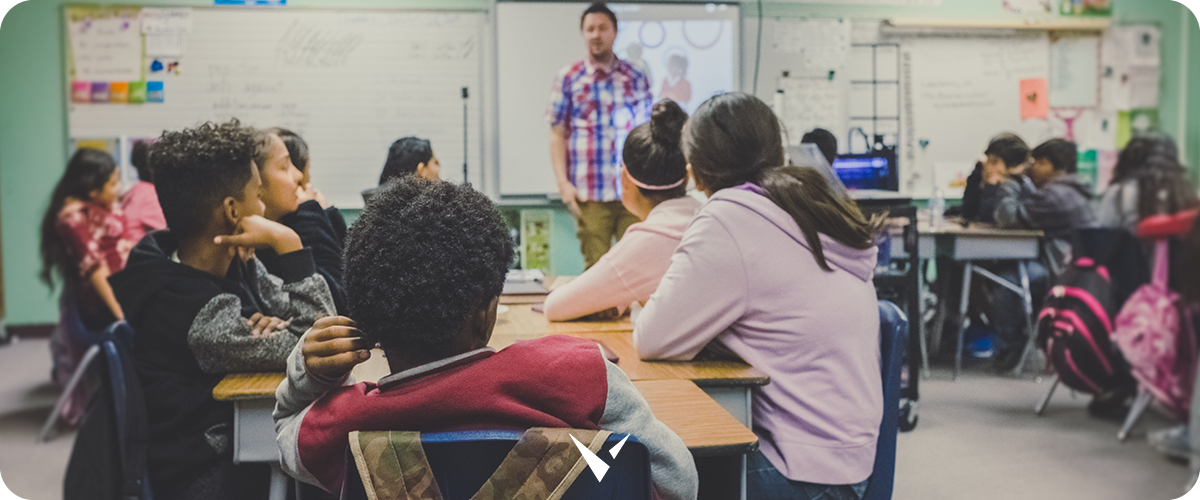
It’s 2022, and many students have gotten accustomed to remote learning because of the pandemic. In the time since classrooms have transitioned back to an in-person learning model, many teachers have continued to elevate their efforts to do more to integrate technology in the classroom.
Technology helps students learn because it’s familiar, and teachers can use platforms kids are already familiar with, like YouTube, to teach them. So how do teachers integrate technology in the classroom?
Many teachers love the idea of using technology in the classroom, but they haven’t figured out exactly which types to use and what they should use it for. This is understandable – there are so many options to survey and so many different opportunities for integrating technology in the classroom that it’s hard to make a decision about where it would be the most beneficial.
As students have fully returned to learning in person, teachers want to take advantage of the in-person connection and communication opportunities that can help assist in learning. The best technologies to keep in the classroom post-pandemic are the ones that help students adjust to life back in the classroom, increase engagement, promote interest, and make learning seem more fun than ever.
Let’s take a look at how teachers integrate technology in the classroom, and how one piece of classroom equipment can expand all these technologies exponentially.
Digital Homework and Tests
The first way teachers can effectively integrate technology in the classroom is with digital homework assignments, turn-in structure, and tests. Gone are the days of completing a homework assignment on paper and delivering it to the teacher’s desk, or reporting that it was eaten by the dog.
During the pandemic, teachers assigned homework virtually, and many of them found that it was incredibly handy and convenient to assign and collect assignments virtually using technology.
Since most students are accustomed to learning from their computer, tablet, or phone, doing homework online seems just as natural, if not more, than writing on a piece of paper.
In fact, online homework assignments help students remember to complete the homework since many systems have reminders and alerts. In addition, students can stay more organized with online work, since paper assignments can get crumpled, messy, and smudged with eraser marks. Kids who need time to think and revise may benefit from online work even more because they can rethink and re-do the assignment or test as many times as they want, if permitted.
Online work assignments also mean that students don’t actually have to take their tests in the classroom. If necessary they can take tests at home, which may be especially helpful if it’s a long written assignment or they need additional time or resources to complete an assignment.
Allowing students to work in their own time frames can be particularly helpful for those who struggle with focus or learning disabilities, so this is an effective classroom technology to incorporate for long-term engagement and learning enjoyment.
Think back to the days when homework assignments were written on a chalkboard. Some students might forget to write it down, write a detail wrong, or lack understanding about the assignments. But with online assignments, you can answer questions about the assignment, help kids remember with alerts and notifications, and provide feedback much more easily and quickly. This feedback can also be shared with their parents in certain apps and technologies.
Examples of online homework and assignment platforms are Google Classroom, Blackboard, Brightspace, and Moodle.
Related: The Benefits of Using Technology in the Classroom
Classroom Computers and Tablets
Older generations can probably hardly imagine what it would have been like to have a tablet or Chromebook at their desk in school. The possibilities are endless – and that’s why many modern teachers incorporate tablets or Chromebooks into their modern education strategies in 2022.
Whether it’s digital homework or help with a tough subject, there’s an app for everything. And what’s more, with technology like screen mirroring, the teacher can greatly expand the reach of those apps by integrating them directly into a classroom lesson and mirroring any student’s screen to the main classroom display at any time.
YouTube, Google Docs, Google Slides, Quizlet, or whatever the student is working with–the teacher can pair both screen mirroring and app technology to create an endless number of teaching moments with the entire classroom.
Teachers integrate technology in the classroom by getting creative with their resources and combining different elements of technology to achieve one overarching purpose – education.
By using this type of technology in the classroom, you can assign kids more exciting, engaging types of work that will prepare them for the real world. Modern marketing professionals use Canva to create posts and content for their organizations. Did you know that students who use technology in the classroom have those exact same skills?
When teachers allow students to work on PowerPoint, Canva, and Photoshop, they are actually preparing them for the real world of college or work – and the students find this type of work exciting. Easily presenting their work via screen mirroring offers additional learning and collaboration skills built right in to every lesson.
Gamified Learning
You know that your students probably love playing games – outside, on their Nintendo or Xbox, and especially on their phones. Teachers are increasingly finding that games are the winning ticket to transforming the classroom and providing an amazing learning and retention experience. It helps maintain attention and focus, and it also helps students more easily learn subject matter that is challenging or tedious.
One answer to how teachers integrate technology in the classroom is indeed through games. Using technology to incorporate in-classroom learning games can help teachers reach students who seem bored or uninterested, and students love the challenge of a game.
Games can also provide that quick validation and boost of success that students love when playing games at home and they achieve a goal. That feeling of winning a “gold star” can certainly help motivate students to want to keep learning – and teachers who use games in the classroom know this.
Games can help students learn spelling, math, concepts, geography, history, and problem-solving skills. The list is endless – and teachers can think strategically about which subjects would be best for games, like math, reading, or science, depending on their classroom subjects and their students’ strengths and weaknesses.
As with the earlier discussion, the best thing about all these games in a classroom environment is that a teacher can use screen mirroring to bring it all together–students can work on their own individual games to work at whatever learning level they’re at, and then they can present their progress to the class. If the teacher has the right screen mirroring tech, this process is effortless.
Related: How to Improve Student Engagement in the Classroom
Document Sharing Technology
Document sharing technology is another way that teachers integrate technology in the classroom. Document sharing isn’t just for teachers and parents – it’s for students too.
With document sharing technology, students can share documents with each other and compare notes, collaborate on projects, and see different points of view. Document sharing is a great way for students to build teamwork skills and communicate with each other, especially if they’re working on a group project. Back in the days before personal computers, students working on a group project all had to be in one place. But now, they can be anywhere, including the classroom, since document sharing allows them to collaborate virtually from any location.
This also allows students to grow in their personal responsibility and accountability skills, since no matter where they are, they are responsible for editing and working on the shared project. Technology like Google Classroom helps teachers incorporate document sharing into their virtual learning stack, and screen mirroring can allow students to easily present their work to the class for speech practice or classroom-wide collaboration.
Related: What Types of Technology Can Be Used in the Classroom?
Interactive and Video Lessons
Some students need to learn in different ways – just sitting in the classroom taking notes isn’t going to cut it. And that’s fine – there are many different types of minds out there. By using technology in the classroom, teachers can help students learn in the best ways for them.
Technologies like Pear Deck help make it easy to create interactive lessons for students who learn by doing instead of listening or watching. Some classroom technologies can even help students submit assignments in creative ways, like videos, pictures, recordings, and more. Students all learn very differently, so using these technologies can help students feel like they’re able to play to their strengths in the classroom.
For teachers, it can be exciting and interesting to see how students expand and grow with the opportunity to learn through different forms of technology. As the world changes and students change, teachers too must change their teaching style to fit modern learning expectations.
So don’t only ask yourself how teachers integrate technology in the classroom, but also why. Sometimes the best way to select the best classroom technology for a classroom, or a district of classrooms, is to ask yourself why and how students would benefit from it.
Here are some of the top reasons that teachers use technology in the classroom:
● Accessibility
● Flexibility
● Increased engagement
● Easy assignment tracking
● Flexible homework
● Flexible testing
● Easier feedback
● Better communication and collaboration
In short, tech in the classroom allows for such a versatile and expansive answer to how teachers integrate technology in the classroom – just like with the learning tech offers students, the possibilities are endless.
Screen Mirroring
A little different from the other educational technologies mentioned here, screen mirroring earns its own section in this article for the way it can help teachers integrate a wide variety of technologies in the classroom and boost student engagement, attention, and interest.
With the right screen mirroring tech, the teacher can manage, share, and display any screen in the classroom at any time. The teacher remains in full control, and this ability aids in transparency, collaboration, and the sharing of ideas.
With the increasing use of technology in classrooms, there’s also an increased amount of technical and IT problems that teachers and students will struggle with – which can put stress on large and small education IT teams alike. Indeed, screen mirroring is a must-have tool for IT departments because it is so versatile for individual or collaborative classroom work when paired with any of the technology already discussed.
Integrate Technology in the Classroom with a Variety of Educational Tech + Screen Mirroring
Vivi offers screen mirroring technology specially designed for education. Teachers can control every screen in the room while wirelessly walking the room, with a simple tap. They can integrate any lesson into a whole new classroom experience with Vivi’s screen mirroring technology.
In addition, school IT departments or central IT teams can virtually command all screens from a central location, broadcast emergency alerts, and communicate with all students easily. Vivi can be managed for an entire school district from one location. It offers IT departments more all-in-one control of a school’s technology and systems with a virtual, easy-to-use platform.
Vivi is the only wireless screen mirroring and digital signage tool designed for education – and it’s perfect for helping teachers integrate any technology in the classroom. Contact us today to learn more about Vivi and get a free trial. See how screen mirroring can transform the way students learn with technology.



